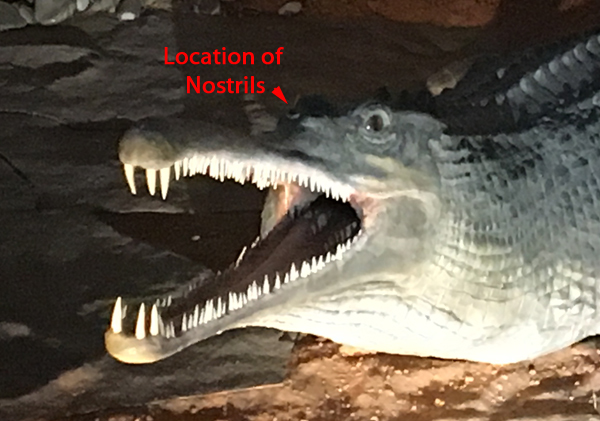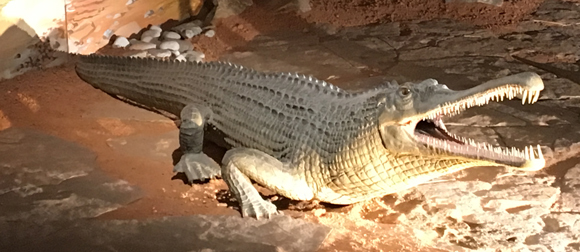Evidence Found of Late Triassic Phytosaurs in Southern Africa
A team of international researchers have reported the discovery of phytosaur fossils from southern Africa. A local safari guide noticed some fossils eroding out of sediments on the shores of Lake Kariba in northern Zimbabwe. Field expeditions to the area were undertaken in 2017 and 2018 and the researchers, which included scientists from the London Natural History Museum, were able to map the fauna and flora of a Late Triassic freshwater ecosystem.
Fragmentary remains including dermal scutes (armour), teeth and bones were found and this is the first evidence that crocodile-like phytosaurs were present in southern Africa. Many palaeontologists thought that these aquatic reptiles were confined mostly to the tropics and sub-tropics. These fossils suggest that phytosaurs may have been more widely distributed than previously thought.
A Museum Exhibit Featuring a Typical Phytosaur (National Museum of Wales)
Picture credit: Everything Dinosaur
Not Closely Related to Modern Crocodiles
Phytosaurs superficially resemble modern crocodiles, especially long, thin snouted forms like the American crocodile and the Gharial, although they are not closely related. It is likely that phytosaurs filled the same ecological niche as extant crocodilians, hunting for fish and small reptiles/amphibians around bodies of freshwater, although it is now known that some phytosaurs adapted to a marine environment: Marine Phytosaurs of the Triassic.
The Phytosauria clade and its superficial similarity to crocodilians is an example of convergent evolution, whereby, similar features and traits evolve in unrelated species. One of the easiest ways to tell a crocodile from a phytosaur is to look at the skull. The jaws and teeth may look similar but with crocodiles the pair of nostrils are located towards the front of the snout whilst in phytosaurs the nostrils are located towards the back of the snout, much closer to the eyes.
The Location of the Nostrils in Phytosaurs

Picture credit: Everything Dinosaur
Mapping the Fossilised Remains of Phytosaurs
Fossilised remains of phytosaurs have been found in Europe, North America, Morocco, Madagascar, India and Brazil. The strata in which these fossils are found would have been at a low latitude when the sediments were laid down. In comparison, the Lake Kariba fossil finds indicate that large phytosaurs were living very far from the equator. Until now, phytosaurs had been unknown from high southerly latitudes.
Professor Paul Barret, (London Natural History Museum), a co-author of the scientific paper stated:
“This is the first discovery of phytosaurs from southern Africa. It provides us with our first snapshot of a mostly aquatic environment from this part of the world, which was part of the ecological puzzle that was missing before.”
The study has also permitted the researchers to properly date the rocks in which the fossils were found, placing the entire site into much greater context with the other Triassic-age formations found across South Africa, Zambia, Tanzania, Namibia and Botswana.
Phytosaurs are Environmental Indicators
The presence of large phytosaurs in Zimbabwe, is a good indicator of the environment and climatic conditions in the area some 210 million years ago.
Professor Barrett explained:
“Phytosaurs usually need permanent bodies of water. They’re big animals that liked large lakes and rivers.”
These kinds of environments would not have been unusual during the Late Triassic, which is one of the reasons why the distinct lack of any phytosaurs from southern Africa is particularly curious.
Everything Dinosaur acknowledges the assistance of a news release from the London Natural History Museum in the compilation of this article.
The Everything Dinosaur website: Everything Dinosaur.







Leave A Comment